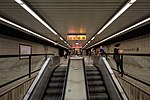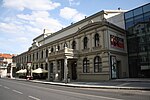Langweil's Model of Prague

Langweil's Model of Prague is a realistic paper model of Prague dating from 1826–1837 and named after its creator Antonín Langweil. Due to Langweil's early death, the model remained unfinished. It covers an area of 20 m2 and shows more than 2,000 buildings in the historic heart of Prague in fine detail; approximately half of them do not exist anymore, largely due to an extensive urban sanitation project that included a planned demolition of large portions of the city's Old, New and Jewish towns between 1896 and 1943. The Langweil Model is thus the only existing depiction of the entire Prague Ghetto in its pre-1890s appearance. It is also a worldwide unique authentic witness of the appearance of a city in the first half of the 19th century.
Excerpt from the Wikipedia article Langweil's Model of Prague (License: CC BY-SA 3.0, Authors, Images).Langweil's Model of Prague
Křižíkova, Prague New Town
Geographical coordinates (GPS) Address Phone number Website Nearby Places Show on map
Geographical coordinates (GPS)
| Latitude | Longitude |
|---|---|
| N 50.09 ° | E 14.438611111111 ° |
Address
Muzeum hlavního města Prahy - hlavní budova
Křižíkova
116 47 Prague, New Town
Prague, Czechia
Open on Google Maps











